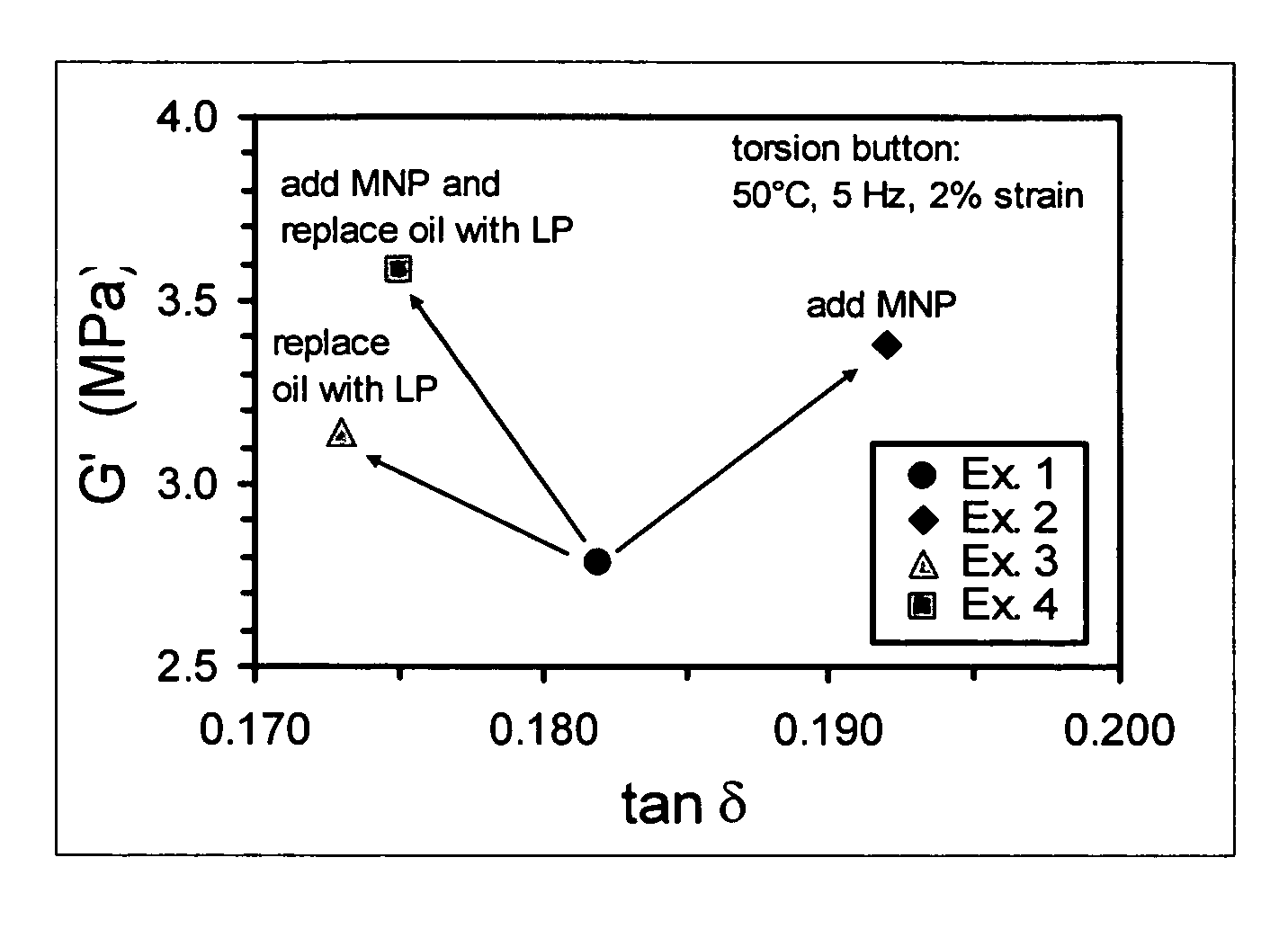Combined use of liquid polymer and polymeric nanoparticles for rubber applications
a technology of liquid polymer and nanoparticles, which is applied in the field of rubber composition, can solve the problems of reducing the durability of tires, challenging and demanding the effect of achieving good reinforcement, and desiring to control hysteresis properties,
- Summary
- Abstract
- Description
- Claims
- Application Information
AI Technical Summary
Benefits of technology
Problems solved by technology
Method used
Image
Examples
example a
The Synthesis of Micelle Nano-Particles
[0107]A 2-gallon reactor was used. Butadiene in hexane blend (21.9 weight percent butadiene), styrene in hexane (33 weight percent styrene), hexane, n-butyl lithium (1.54 M), OOPS modifier (1.6 M), isopropanol and BHT were used as supplied. Divinylbenzene was purchased from Aldrich (80% divinylbenzene) and stored on alumina beads and calcium hydride.
[0108]The reactor was charged with 4.80 lbs hexane and 3.98 lbs of the butadiene in hexane blend. The jacket of the reactor was heated to 165° F. When the batch reached 153° F., 2.5 mL of 1.54 M n-butyl lithium were added, diluted with about 20 mL of hexane. The polymerization exothermed at 191.7° F. after 14 minutes of reaction. After ½ hour, the jacket of the reactor was set to 100° F. A sample was dropped for analysis. Some n-butyl lithium (7.5 mL) was added. A mixture of styrene blend (349.2 g) and DVB (45.5 mL) was prepared in a bottle and added to the reactor. The jacket temperature of the rea...
example b
The Synthesis of a Liquid Polymer
[0110]A 2-gallon reactor was used. Butadiene in hexane blend (21.4 weight percent butadiene), hexane, n-butyl lithium (1.60 M), OOPS modifier (1.6 M), isopropanol and BHT were used as supplied.
[0111]The reactor was charged with 2.99 lbs hexane and 7.00 lbs butadiene in hexane blend. The jacket of the reactor was heated to 140° F. When the batch reached 113° F., 5.3 mL of 1.60 M n-butyl lithium were added, diluted with about 20 mL of hexane. The polymerization exothermed at 177.9° F. after 33 minutes of reaction. After 1 hour, the temperature was brought down and the mixture was dropped in isopropanol containing BHT. The solvents were then removed through evaporation and drying in a vacuum oven.
[0112]Measurement using GPC indicated that the liquid polymer had an average molecular weight of 80K, (80 kg / mol)
examples 1-4
Compounding
[0113]A matrix polybutadiene obtained from Firestone Polymer Company under Trade name HX301 was used. The matrix polybutadiene had a molecular weight of about 150,000, a 12% vinyl butadiene and a 40 Mooney viscosity. Rubber compositions were prepared according to Table 4 under the conditions shown in Tables 1-3. In the formulations, the amounts of matrix rubber, aromatic oil, micelle nano-particles, and liquid polymer were varied. The synthesized nano-particle from Example A was selectively used to replace 15 phr of the matrix polubutadiene in the compound formulation (Example 2). The synthesized nano-particle from Example A was selectively used to replace 15 phr of the matrix polubutadiene and the liquid polymer from Example B was sused to replace the aromatic oil (Example 4). Two controls (i.e., Example 1 and 3) were used for setting up a comparison with the test compounds. One was the conventional formulation (Example 1); and the other (Example 3) was the formulation w...
PUM
| Property | Measurement | Unit |
|---|---|---|
| glass transition temperature | aaaaa | aaaaa |
| glass transition temperature | aaaaa | aaaaa |
| glass transition temperature | aaaaa | aaaaa |
Abstract
Description
Claims
Application Information
 Login to View More
Login to View More - R&D
- Intellectual Property
- Life Sciences
- Materials
- Tech Scout
- Unparalleled Data Quality
- Higher Quality Content
- 60% Fewer Hallucinations
Browse by: Latest US Patents, China's latest patents, Technical Efficacy Thesaurus, Application Domain, Technology Topic, Popular Technical Reports.
© 2025 PatSnap. All rights reserved.Legal|Privacy policy|Modern Slavery Act Transparency Statement|Sitemap|About US| Contact US: help@patsnap.com



